
Eudonia philerga is a species of moth of the family Crambidae. This species was first described by Edward Meyrick. It is endemic to New Zealand, found throughout the country, and regarded as common. Larvae feed on moss. Adult moths have been observed on the wing more frequently from October to April, and are attracted to light.

Asaphodes is a genus of moths in the family Geometridae erected by Edward Meyrick in 1885. This genus is endemic to New Zealand and species within this genus are found throughout New Zealand including the North, South and Stewart / Rakiura Islands.

Hendecasticha is a genus of moths belonging to the subfamily Olethreutinae of the family Tortricidae. This genus was described by Edward Meyrick in 1881. It consists of only one species, Hendecasticha aethaliana, which is endemic to New Zealand.

Parienia is a genus of moths belonging to the subfamily Olethreutinae of the family Tortricidae. This genus was described by Edward Meyrick in 1881. It consists of only one species, Parienia mochlophorana, which is endemic to New Zealand.
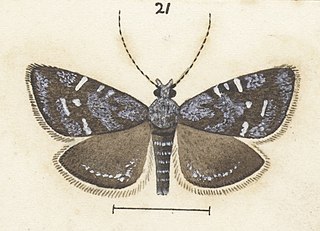
Asterivora symbolaea is a species of moth in the family Choreutidae. It is endemic to New Zealand and has been observed in Arthur's Pass. This species lives in subalpine habitat. Adults of this is on the wing in January and February. Larvae are hosted by Celmisia prorepens.

Cryptaspasma querula is a moth of the family Tortricidae. It is endemic to New Zealand and can be found throughout the country. This species inhabits podocarp and broadleaf forest. The larvae consume parts of the seeds and fruits of tawa, tarairi and miro trees and are predated upon by the invasive to New Zealand house mouse. Larvae pupate in leaf litter under their host trees. Adults are variable in appearance and also in size. They are on the wing throughout the year and are nocturnal but are attracted to light. They can be found having flown inside houses and have also been observed resting on fences or other human made structures during the day.

Elachista ochroleuca is a moth in the family Elachistidae. It was described by Edward Meyrick in 1923. It is endemic to New Zealand and has been observed in the South Island. The adults of this species are day flying and are on the wing from October until March.

Elachista eurychora is a species of moth in the family Elachistidae. This species is endemic to New Zealand and has only been collected at Paekākāriki. The habitat where the adult moth was originally collected was in rough vegetation on coastal sandhills or dunes but the collection locality has been significantly modified since that time. It has been hypothesised that the host of the larvae of this species is a grass. Adults are on the wing in March. It is classified as "Data Deficient" by the Department of Conservation.

Asaphodes chlamydota is a moth in the family Geometridae. It is endemic to New Zealand, and can be found in the lower part of the North Island and in the South Island. It inhabits native forest and shrublands. The larvae of this species feeds on native Clematis plants including Clematis afoliata. Adults are on the wing from November to April and are regarded as having intermedia flight powers.
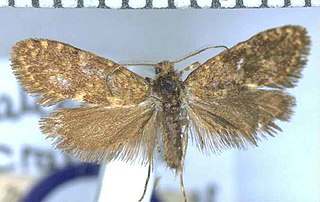
Mallobathra is a genus of moths belonging to the family Psychidae, and are bagworm moths. This genus was first described by Edward Meyrick. It is endemic to New Zealand. The type species of this genus is Mallobathra crataea.

Tingena nycteris is a species of moth in the family Oecophoridae. It is endemic to New Zealand and has been observed in the North and South Islands. This species inhabits native forest and scrubland and adults are on the wing from October to January.
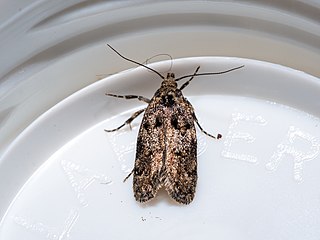
Trachypepla anastrella is a species of moth in the family Oecophoridae. It is endemic to New Zealand and has been observed in the North and South Islands. Larvae are leaf litter feeders from the host plant Olearia fragrantissima and adults are on the wing from December until March.
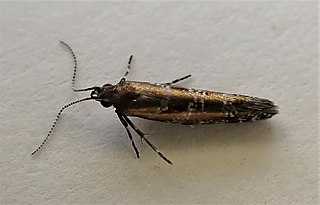
Chrysorthenches drosochalca is a species of moth in the family Plutellidae first described by Edward Meyrick in 1905. It is endemic to New Zealand and has been found in the North and South Islands. The larvae are leaf miners of Prumnopitys ferruginea. Adults are on the wing from January to March.

Chrysorthenches porphyritis is a species of moth of the family Plutellidae. It was first described by Edward Meyrick in 1885 and is endemic to New Zealand. This species can be found on both the North and South Islands in open native forest and scrub at altitudes from sea level up to 1370 m. The larvae feed on Podocarpus laetus, P. totara, P. nivalis, and Phyllocladus alpinus. The larvae create a shelter by loosely spinning together the leaves of its host plant and can be found feeding in groups. The pupa is formed inside a thin cocoon. Hudson was of the opinion that this species had two broods a year. Adult moths are on the wing all year round. The adults of this species, particularly the female, are variable in colouration and in forewing pattern.

Strepsicrates sideritis is a species of moth in the family Tortricidae first described by Edward Meyrick in 1905. This species is endemic to New Zealand. The classification of this moth within the genus Strepsicrates is regarded as unsatisfactory and in need of revision. As such this species is currently also known as Strepsicrates (s.l.) sideritis.

Holocola charopa is a species of moth in the family Tortricidae. It was first described by Edward Meyrick in 1888. It is endemic to New Zealand and has been observed in the northern parts of the North Island. The larvae web together and feed on the new shoots of their host plant Kunzea ericoides. Adults are on the wing in July and from November until February.
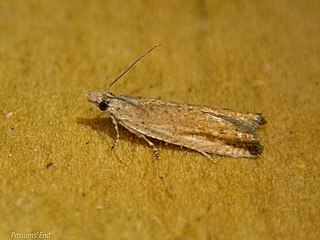
Holocola zopherana is a species of moth in the family Tortricidae first described by Edward Meyrick in 1881. This species is found in Australia and New Zealand. The larval hosts of this moth are Kunzea ericoides as well as species within the plant genus Leptospermum.

Holocola emplasta is a species of moth in the family Tortricidae. This species is endemic to New Zealand and has been observed in the South Island. The larval hosts are species within the genus Coprosma. Adults of the species are on the wing during the New Zealand spring months.

Holocola parthenia is a species of moth in the family Tortricidae. It is endemic to New Zealand and has been observed in the North, South and the Chatham Islands. Larvae feed on Leucopogon fasciculatus. This moth is one of the earliest to emerge in the New Zealand spring with adults being observed from August to December. Adults are attracted to light.

Prothelymna potamias is a species of moth in the family Tineidae first described by Edward Meyrick in 1909. This species is endemic to New Zealand.




















